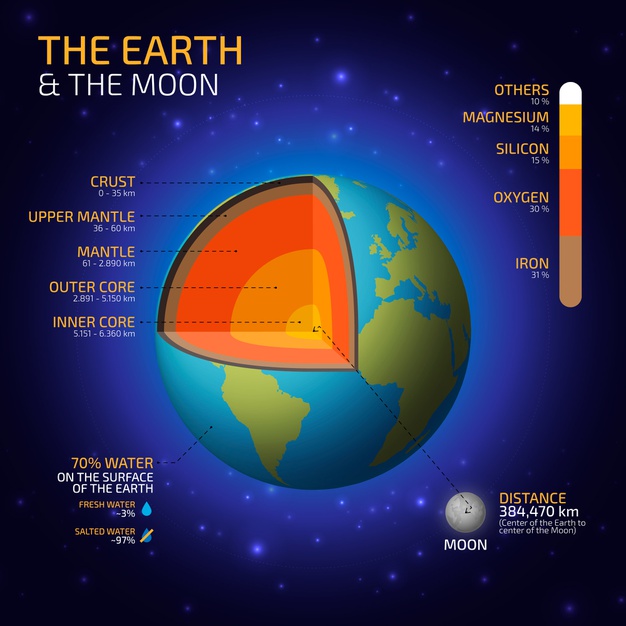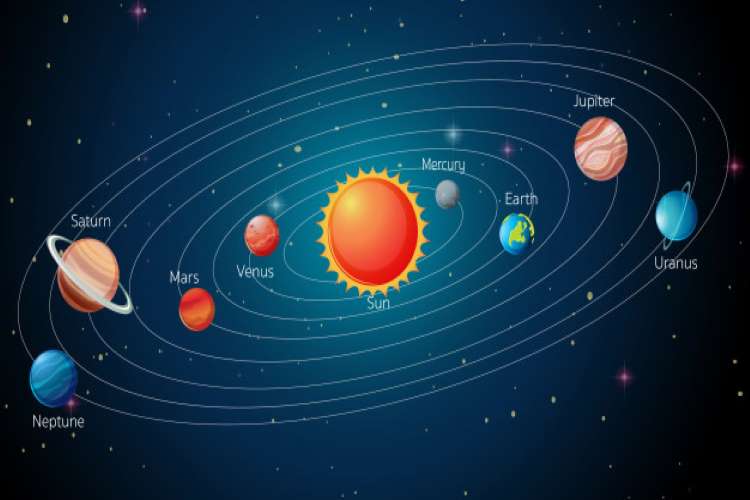When we look up in the sky, we see the blue colour, the sun in the daytime, and the moon, and the beautiful stars in the night. But it’s way beyond that. There are many galaxies, so many that we can’t even count them all yet! Out of which, we have a milky way galaxy in which we have our Solar System.
Our solar system has eight planets, and we live on Earth. How and why we live on Earth, and why not on some other planet? Do you now have the same question? If yes, do not worry! Let’s dig into this together and have a glance at 10 interesting facts about Earth.
Amazing Facts about Earth
The Earth is the third planet in our solar system that orbits around the Sun, and when seen from outer space, it appears bluish and bright. Scientists believe that the Earth is 4.6 billion years old. Shocking, right? Let’s know the 10 interesting facts about Earth for kids.
Ten Interesting Facts about Earth
-
Is it Round?
No. It’s not round as it appears in images or our minds. Its shape is nearly spherical, but a better approximation of Earth’s shape is an oblate spheroid, which is a sphere flat from the top, which makes the circumference around the poles less than the circumference around the equator. There is a slight flattening at the poles and bulging around the equator due to Earth’s rotation.
Bonus fact – The equatorial diameter is 43 kilometres larger than the pole-to-pole diameter.
-
Why do We have 365 Days in One Calendar Year?
The Earth orbits around the Sun. It takes 365.25 days to go around the Sun once, which is equal to one calendar year.
Earth’s orbital speed averages about 29.78 km/s, which is fast enough to travel a distance equal to Earth’s diameter (12,742 km) in seven minutes. But with this, one thing popped up, i.e., how can something stay around the sun and orbit around it this fast? The answer to this is Pull of the Gravity of the Sun.
Also Read Science Project Ideas for Kids: 5 Ideas for Kids Under 15
-
We are always Moving – surprising, Right?
The second motion of Earth, in addition to orbiting, is spinning. The Earth rotates around its own axis eastwards, and completes one rotation in 24 hours.
Bonus fact – Someone standing on a north pole or south pole would be perfectly still, but people on the equator move the fastest.
Wondering, what are the interesting facts about Earth that The Real School Of Montessori will provide? Keep reading to know more; it will surprise you!
-
The only Planet which Supports Life
Out of eight planets in the solar system, Earth is the only planet that supports life – this is big! Not only it contains life, but it supports millions of different forms of life. Life is possible on Earth because it has water on its surface and oxygen gas in its air. Well, it’s the only world known to support an atmosphere with free oxygen and oceans of liquid water on the surface. Earth also has the perfect range of temperature for life. It’s neither too hot nor too cold, which is another factor responsible for supporting life on Earth.

-
Composition of Earth
The Earth is composed of many layers – Crust, Mantle, Outer Core, Inner Core. The crust is on the outside, and it is a rocky layer. The crust is followed by the mantle, followed by the outer core, and finally, the inner core. The planet Earth is made up of many elements. The core of the Earth is made of mostly iron and nickel. The rock constituents of the crust are nearly all oxides, but chlorine, sulfur, and fluorine are the exceptions, as their total amount is usually much less than 1%. The outermost layer of the Earth consists of several elements. The most abundant are oxygen, silicon, aluminium, iron, and calcium.

-
Earth and the Moon
The Moon is the only natural satellite of Earth. Guessing what a satellite is? It is an object in space that revolves around another object of larger size. The Earth’s Moon is the fifth-largest moon in the solar system, which means it is the fifth-largest in our solar system. The moon is about 384,000 kilometres from the Earth.
Bonus fact – Earth has only one natural satellite, i.e., Moon. However, Mercury and Venus have none, and all the other planets in our solar system have more than one.
Also Read Science Project for Kids: List of Benefits of Projects for Kids
-
Why the Change of Seasons?
When Earth rotates, it is tilted in relation to the plane, which is an imaginary surface through the planets’ orbit around the Sun. When Earth revolves around the Sun, one side of the Earth is tilted towards the Sun, i.e., for about half the year, the North Pole is tilted toward the Sun, and for the other half, the South Pole is tilted towards the Sun.
Think! What will happen if one side of the pole is tilted towards the Sun. Clearly, that side of the pole will receive more sunlight. Therefore, in one half, the northern hemisphere gets more sunlight than the southern hemisphere. During another half, the southern hemisphere gets more sunlight than the northern hemisphere. This difference causes the seasons.
For example, the northern hemisphere has the warmest season, while at the same time, the southern hemisphere may have the coldest season.
-
Earth since Formation
The planet Earth has everything that a jaw-dropping blockbuster movie can have, from plains to hills, from oceans to volcanoes, to terrains coldest, hottest, deepest, and highest. Scientists believe that Earth is 4.6 billion years old, and it has greatly changed since then. Some changes have taken millions of years to take place by wind and water, and some changes in the surrounding land took just a few hours, like erupting volcanoes and Earthquakes.
Those who study these changes are called geologists. The Earth’s history is divided by geologists into periods called aeons and eras. These periods are used to explain how and when changes on Earth took place.

-
The Geography of Earth
The land covers about 29 percent of Earth’s surface. The Earth has seven large landmasses called continents: Africa, Asia, North America, South America, Europe, Australia, and Antarctica.
71% of Earth’s surface is covered with water, and it is in the form of oceans, rivers, lakes, and groundwater. Earth has five major water bodies: the Arctic, Atlantic, Pacific, Southern, and Indian oceans. They surround the continents. Some water is frozen, for example, large ice sheets in the Arctic and Antarctic regions.
Bonus fact – The highest point above sea level on Earth is Mount Everest, and the lowest point is the Mariana Trench.
-
Earth’s Atmosphere
The layer of gases surrounding Earth is called the atmosphere. This is the air that living things breathe. Earth’s atmosphere is made up of nitrogen (78%) and oxygen (21%) mostly. It also contains water vapour and other gases that are a part of the atmosphere, including argon, carbon dioxide, neon, helium, hydrogen, and more. Plants use carbon dioxide for photosynthesis, and animals breathe oxygen to survive. The Earth’s atmosphere is divided into five major layers:- Troposphere, Stratosphere, Mesosphere, Thermosphere, Exosphere.
Conclusion
We at the The Real School Of Montessori ensure good all-around exposure for your kids. You must try our free trial class, where you will get to know that we don’t want to scratch the surface by gamifying math and animating science or sell a tablet full of videos. We want to work on the very foundation of what we learn, how we learn, and why we learn.







